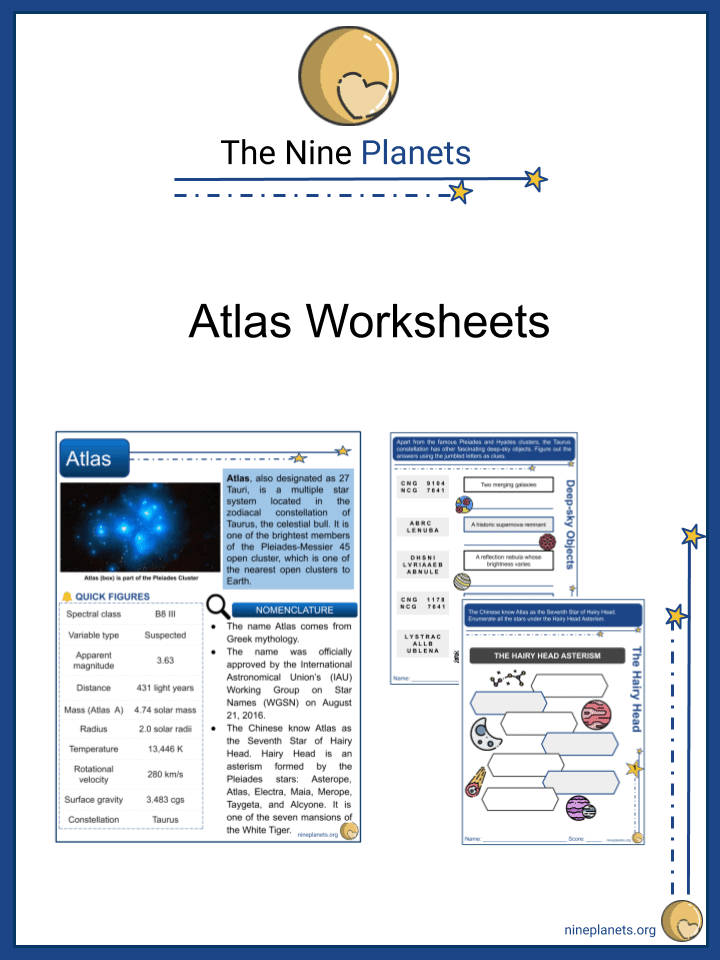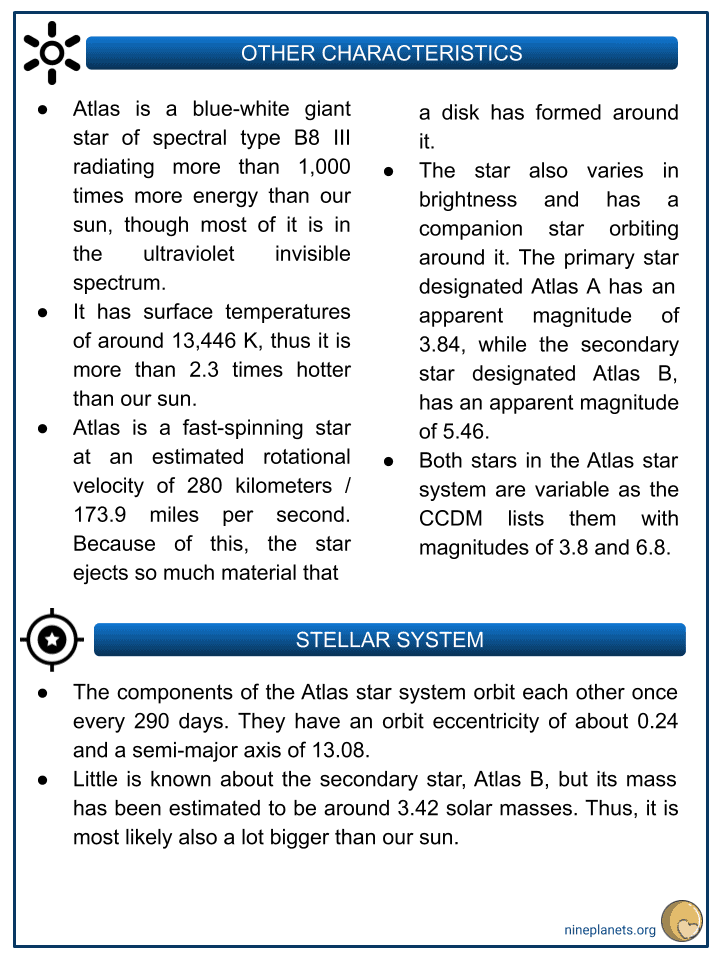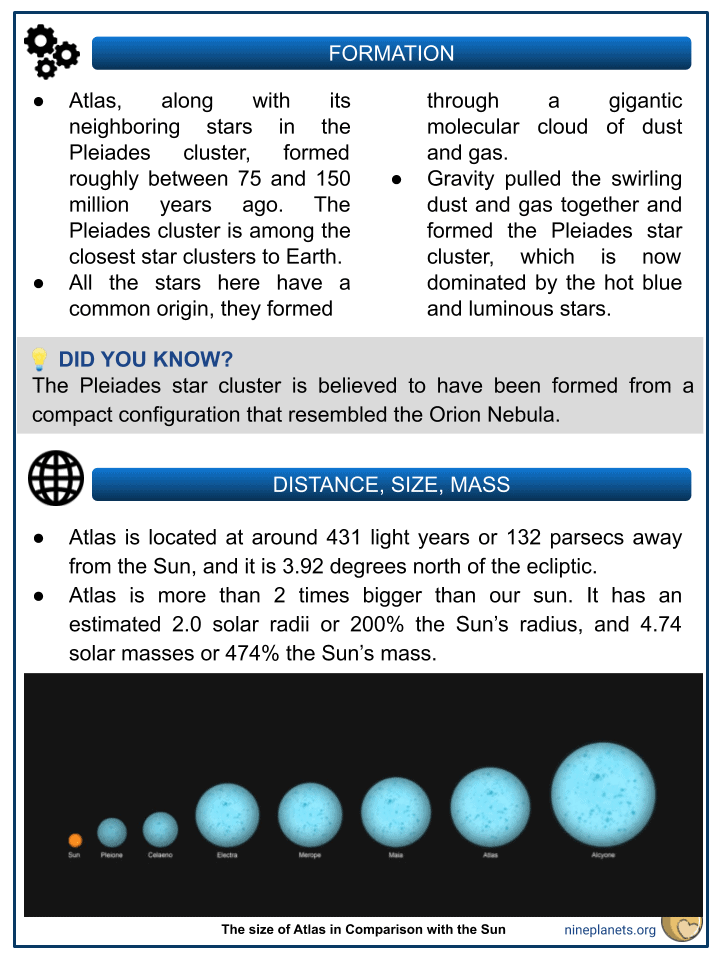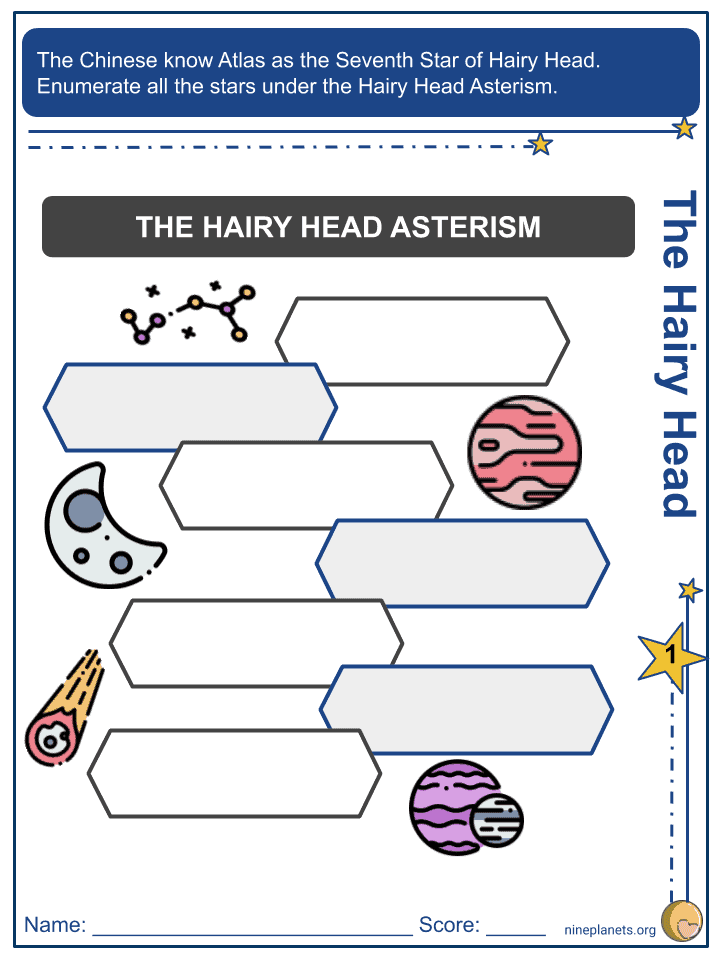Download Atlas Worksheets
Click the button below to get instant access to these premium worksheets for use in the classroom or at a home.

This worksheet can be edited by Premium members using the free Google Slides online software. Click the Edit button above to get started.
Download free sample
Not ready to purchase a subscription yet? Click here to download a FREE sample of this worksheet pack.
Resource Examples
Click any of the example images below to view a larger version.




Key Facts & Information
- Atlas, also designated as 27 Tauri, is a multiple star system located in the zodiacal constellation of Taurus, the celestial bull. It is one of the brightest members of the Pleiades-Messier 45 open cluster, which is one of the nearest open clusters to Earth.
Quick Figures
- Spectral class: B8 III
- Variable type: Suspected
- Apparent magnitude: 3.63
- Distance: 431 light years
- Mass (Atlas A): 4.74 solar mass
- Radius: 2.0 solar radii
- Temperature: 13,446 K
- Rotational velocity: 280 km/s
- Surface gravity: 3.483 cgs
- Constellation: Taurus
Nomenclature
- The name Atlas comes from Greek mythology.
- The name was officially approved by the International Astronomical Union’s (IAU) Working Group on Star Names (WGSN) on August 21, 2016.
- The Chinese know Atlas as the Seventh Star of Hairy Head. Hairy Head is an asterism formed by the Pleiades stars: Asterope, Atlas, Electra, Maia, Merope, Taygeta, and Alcyone. It is one of the seven mansions of the White Tiger.
Formation
- Atlas, along with its neighboring stars in the Pleiades cluster, formed roughly between 75 and 150 million years ago. The Pleiades cluster is among the closest star clusters to Earth.
- All the stars here have a common origin, they formed through a gigantic molecular cloud of dust and gas.
- Gravity pulled the swirling dust and gas together and formed the Pleiades star cluster, which is now dominated by the hot blue and luminous stars.
- The Pleiades star cluster is believed to have been formed from a compact configuration that resembled the Orion Nebula.
Distance, Size, Mass
- Atlas is located at around 431 light years or 132 parsecs away from the Sun, and it is 3.92 degrees north of the ecliptic.
- Atlas is more than 2 times bigger than our sun. It has an estimated 2.0 solar radii or 200% the Sun’s radius, and 4.74 solar masses or 474% the Sun’s mass.
Other Characteristics
- Atlas is a blue-white giant star of spectral type B8 III radiating more than 1,000 times more energy than our sun, though most of it is in the ultraviolet invisible spectrum.
- It has surface temperatures of around 13,446 K, thus it is more than 2.3 times hotter than our sun.
- Atlas is a fast-spinning star at an estimated rotational velocity of 280 kilometers / 173.9 miles per second. Because of this, the star ejects so much material that a disk has formed around it.
- The star also varies in brightness and has a companion star orbiting around it. The primary star designated Atlas A has an apparent magnitude of 3.84, while the secondary star designated Atlas B, has an apparent magnitude of 5.46.
- Both stars in the Atlas star system are variable as the CCDM lists them with magnitudes of 3.8 and 6.8.
Stellar System
- The components of the Atlas star system orbit each other once every 290 days. They have an orbit eccentricity of about 0.24 and a semi-major axis of 13.08.
- Little is known about the secondary star, Atlas B, but its mass has been estimated to be around 3.42 solar masses. Thus, it is most likely also a lot bigger than our sun.
Location
- Atlas is located in the zodiacal constellation of Taurus, the celestial bull. It is part of one of the two famous open clusters of the constellation named the Pleiades and the Hyades.
- The constellation itself is one of the largest in the night sky, and also one of the most prominent of the northern constellations occupying an area of 797 square degrees.
- Taurus is very easy to identify. The bright Aldebaran, found along the imaginary line extended from Orion’s Belt, marks the Bull’s eye and the Hyades stars outline its head, while Elnath (Beta Tauri) and Tianguan (Zeta Tauri) mark the Bull’s horns.
- One of the best months in which these celestial objects can be seen and studied, is during the month of January, however, when it comes to Atlas and the Pleiades cluster, in particular, it differs.
- Apart from the famous Pleiades and Hyades clusters, the Taurus constellation has other fascinating deep-sky objects such as:
- Crab Nebula – a historic supernova remnant
- Crystal Ball Nebula – planetary nebula the open clusters NGC 1817 and NGC 1647 the merging galaxies NGC 1409 and NGC 1410
- Hind’s Variable Nebula – a reflection nebula whose brightness varies because it is illuminated by the young variable star T Tauri.
- The 10 brightest stars in the constellation:
- Aldebaran (Alpha Tau, mag. 0.86)
- Elnath (Beta Tau, mag. 1.65)
- Alcyone (Eta Tau, mag. 2.87)
- Tianguan (Zeta Tau, mag. 2.97)
- Chamukuy (Theta2 Tauri, mag. 3.40)
- Lambda Tauri (mag. 3.47)
- Ain (Epsilon Tau, mag. 3.53)
- Omicron Tauri (mag. 3.61)
- Atlas (27 Tau, mag. 3.63)
- Prima Hyadum (Gamma Tau, mag. 3.654)
Pleiades Member
- Many stars, including Atlas, in the Pleiades open cluster, can be best seen during the months of October to April. May and June are not suitable for observation since the cluster is too close to the Sun.
- One of the first telescopic observations conducted on the Pleiades was during the 1610s. Galileo Galilei observed the bright stars and the cluster and it is noted that he may well be the first to have done so.
- The Pleiades open cluster is one of the closest star clusters to Earth, and one of the brightest, and biggest in our vicinity. Atlas itself is the second brightest star of this cluster.
- To find the Pleiades cluster, one can draw an imaginary line from the stars of Orion’s Belt – Alnitak, Alnilam, and Mintaka – past Aldebaran – though this isn’t required since the cluster is so bright that it can be hard to miss in the first place.
- The Pleiades cluster is also known as Messier 45. Most of the brightest and hottest stars that reside here are of spectral class B, and they formed between 75 and 150 million years ago.
- The Pleiades are mentioned in the Kojiki as the Mutsuraboshi – translating to “six stars.” In modern Japan, the cluster is now known as Subaru – the same name used by the famous automobile company that depicts the six brightest stars in their logo.
- Most of these stars are far apart from one another, at around 444 light years. The most documented and famous stars are all named after the mythological Seven Sisters and their parents from Greek mythology. The nine stars are Alcyone, Asterope, Celaeno, Electra, Maia, Merope, Taygeta, Atlas, and Pleione.
- Since ancient times, many cultures throughout the world knew of the Pleiades cluster. One of the earliest depictions of the Pleiades cluster and its stars resides in the Nebra sky disk – a Bronze Age artifact dating to 1.6000 BCE, uncovered in Germany.
The Future
- Atlas will continue to exist for many millions of years, however, the Pleiades star cluster has been studied closely and many computer simulations predict a grim future.
- Most simulations suggest that the cluster will continue to survive for 250 million years before it will start to disperse due to gravitational interactions with its galactic neighborhood.
Greek Mythology
- The mythological story depicts the sisters as they caught the eye of Orion, a giant huntsman.
- Atlas was one of the Titans who opposed the Olympian gods, and though powerful, lost to them in battle. After the war was won by the Olympian gods, many Titans were punished for their deeds and locked away.
- Atlas, being condemned for his battles against the gods, was condemned to carry the heavens on his shoulders, while Orion, the giant, pursued his daughters.
- He, along with with the Oceanid nymph Pleione, are the parents of the Pleiades and the Hyades, (now the names of the famous open clusters of Taurus).
- However, the Greek god Zeus stepped in and transformed the sisters into doves, and then into stars to console their father.
- Even so, Orion, the giant, is still pursuing the Pleiades sisters across the sky, represented by the Orion constellation.
- Many famous and ancient texts mention the cluster, such as Homer’s Illiad and Odyssey, Hesiod’s Works and Days, the Bible, the ancient Egyptian Calendar of Lucky and Unlucky Days, and the Japanese Kojiki – An Account of Ancient Matters – the 8th-century chronicle of myths, oral traditions, and legends.